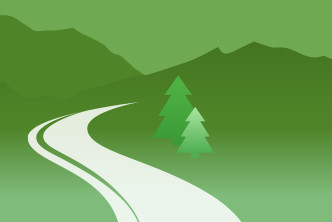Spanning just over 6 miles, the Casper Rail Trail offers an east-west route across the charming Wyoming community of Casper. Loosely paralleling US Highway 26, the paved pathway partially follows the former Chicago and North Western Railway. Attractions along the route include The Science Zone, the country library, the Nicolaysen Art Museum and Veteran's Park. Just two blocks north of the trail on its west end, you'll also find shops and restaurants to enjoy before or after your trail adventure.
For a longer ride, pick up the nearby Platte River Parkway, which offers a paved riverside route through the north end of town.
Future plans call for extending the rail-trail east to Edness Kimball Wilkins State Park with amenities such as pocket parks, benches, and an adjacent running trail.
This trail is a gateway to the Great American Rail-Trail, a nearly 4,000 mile developing trail that will connect the country from Washington, D.C., to Washington state. Gateway trails represent those iconic trails that make the Great American Rail-Trail possible in each of the states it connects.
Parking is available at Veteran's Park (510 E. 2nd St, Casper). On-street parking is also available in the commercial areas of town.

Great trails, lots of directions to travel. Some concrete and other asphalt surfaces, as well as some gravel. You can pretty much see all of Casper from this trail.

Terrible ride from Yellowstone. Soft sand and then you get blocked by construction. We went through town and was able to reconnect and went to the River trail and came by by the highway. 19 miles round trip. Not recommended in 2021.

The trail is 6 miles round trip. Starts at Bacco’s and ends at N Walsh. Not a bad ride. Several stops across city streets. Outside of the maps, there are no other markers to transition to other trails. Hoping for a better day of trails tomorrow

In July 2020 I walked three miles of the trail from the west end to Walsh Avenue. This goes through the downtown area of Casper. East of there it parallels Highway 26 (Yellowstone Highway) and, a bit farther away to the south, I-25 towards Glenrock, out to the Hat 6 road.
The entire section I walked is concrete. The two westernmost blocks have been obliterated to make way for a large building under construction as I write this. The building stretches right across the old C&NW right-of-way. West end access is now at Ash Street.
The trail has no sanitary facilities, but the first mile and a half, through the downtown area, has plenty of places where one can stop and use facilities, including the Natrona County Library about half a mile from the west end.
For those interested in the old railroad "flavor" that surrounds some trails, you'll be sorely disappointed here. Nothing much still exists from the time the tracks were here. All the railroad structures are gone, and there's little evidence of the industries the railroad used to serve, either.
But it is a pleasant walk, although after the first mile and a half or so, there's not a lot of shade (though there are maps and benches for resting, periodically) further east.
Some liberties were taken in routing the trail off of, but nearby, the old railroad grade. At Beverly Street crossing, a very nicely land- and hard-scaped underpass has been built for the trail, where the rail line crossed at grade. A bit further east the trail parallels the grade at a couple points, with the grade being very obvious by it raised flat roadbed to the left (as you walk eastward) of the trail.





_284427_nb.jpg)



_284406_nb.jpg)




This community cultural center used to be Friendship Baptist Church, an African American congregation formed in 1875. The congregation commissioned...

In the 19th century, the neighborhood south of the National Mall resembled New York City’s working-class neighborhoods more than the genteel row...

Although the Chinatown Friendship Archway was built in 1986, a Chinese community has lived and owned businesses in this area of Northwest Washington,...

The Great American Rail-Trail promises an all-new American experience. Through 12 states and the District of Columbia, the trail will directly serve nearly 50 million people within 50 miles of the route. Across the nation—and the world—only the limits of imagination will limit its use.
Learn More
TrailLink is a free service provided by Rails-to-Trails conservancy
(a non-profit) and we need your support!